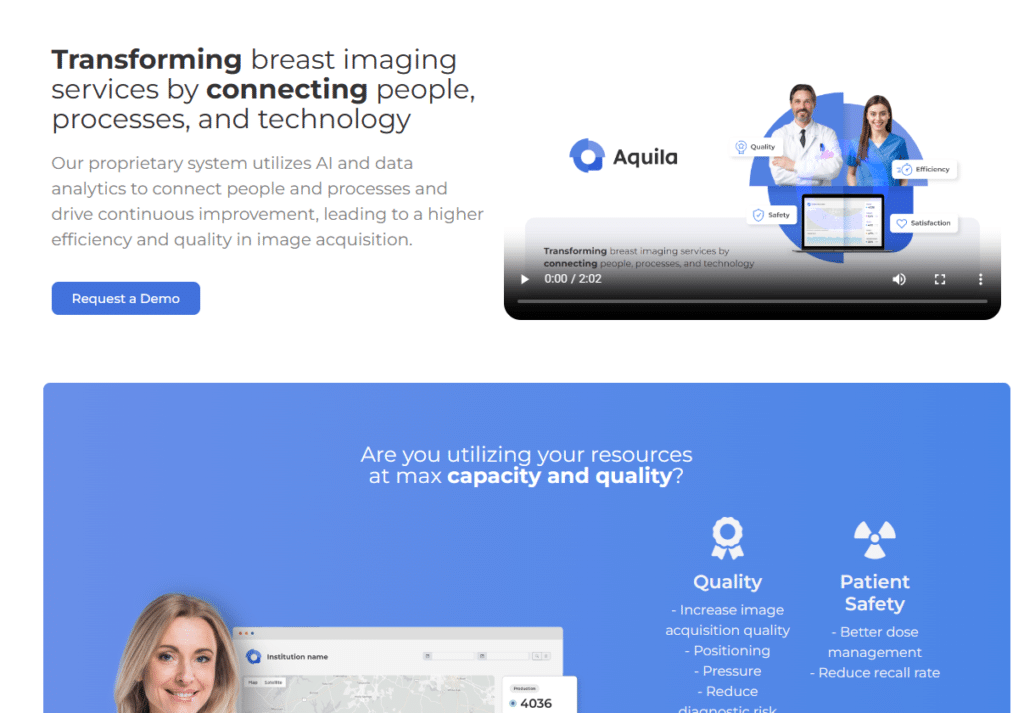While some companies try to completely replace humans with technology, Aquila AI is a technology company that improves breast imaging care. Through their use of a technological system that streams artificial intelligence and data analytic codes to link experts and processes and continuously strives for improvement, this company improves the quality of breast imaging acquisition. While this service can provide higher quality imaging and a faster way to get images, there could be disadvantages as well. In this essay, I will discuss the main qualities of this smart service and highlight the pros and cons of it. To do just that, I will also compare this technology company with others.
Table of Contents
Features of Aquila AI
Aquila.ai offers the following features to help breast imaging service providers improve their quality and efficiency:
- AI-powered Image Analysis and Feedback: Aquila AI applies AI to scrutinize breast images, furnishing feedback on positioning, pressure, and radiation dosage. Moreover, it tenders suggestions to refine image quality, curtailing diagnostic jeopardy and recall frequency.
- Data-driven Performance Management and Optimization: Aquila AI employs data analytics to oversee and gauge the functionality of machineries and technologists, and provide perspectives as well as suggestions on ways of how to make better use of resources while reducing cost. Also, it also aids in uncovering the cause behind bottlenecks and failures in the image acquisition process.
- Training and management support: Aquila.ai offers training and management support to radiologists and technologists to enhance their capabilities and standardize image acquisition processes. This support enables them to improve diagnostic accuracy, align their objectives with industry standards, and meet customer expectations effectively.
Benefits of Aquila AI
- Better quality and patient safety: Aquila AI can help improve the quality and patient safety of breast imaging services, by providing feedback and guidance on how to acquire the best images possible, and by reducing the errors and the risks associated with the image acquisition. Aquila.ai can also help prevent defects and bugs from reaching production and affecting patient care.
- Higher efficiency and cost savings: Aquila AI can help increase the efficiency and cost savings of breast imaging services, by providing insights and recommendations on how to use the resources at the maximum capacity and quality, and by reducing waste and underutilization. Aquila.ai can also help shorten the test cycle time and the cost and increase the profit margin.
- Better satisfaction and competitiveness: Aquila.ai can help improve the satisfaction and the competitiveness of the breast imaging service providers, by providing them with a system that helps them deliver better value and quality to their customers, and by helping them keep up with the industry shift and the market demand. Aquila.ai can also help them become centers of excellence or maintain their status as such.
Drawbacks of Aquila AI
Aquila.ai also has some drawbacks that users should be aware of:
- Limited scope and applicability: While Aquila.ai is a valuable system for breast imaging services, it’s essential to recognize that its design is specific to this domain. Users should be aware that it may not be directly applicable or compatible with other types of imaging services or modalities. In such cases, alternative systems or tools might be necessary, and users could encounter challenges when integrating or synchronizing them with Aquila AI.
- Potential reliability and security issues: Aquila.ai, being an AI-driven system, provides feedback and insights based on data analytics. However, users should exercise caution regarding its accuracy and reliability. It’s advisable to verify and validate the results and suggestions from Aquila.ai, as discrepancies or inconsistencies may arise. Additionally, users dealing with sensitive or confidential data should be aware of security and privacy risks. Ensuring compliance and obtaining consent from customers and regulators is crucial in such cases.
- High learning curve and dependency: Aquila AI demands that users invest time in comprehending its features and functionalities to use them effectively and efficiently. Training and education may be necessary, and users could encounter challenges or resistance during system adoption. Additionally, there’s a risk of dependency on Aquila.ai, potentially leading to a decline in users’ own skills and knowledge related to image acquisition and diagnostics.
Comparison with competitors
- Volpa: It is a company that provides AI-powered software to facilitate personalized and quality breast cancer screening. They have three main tools: VolparaDensity measures breast density and assesses cancer risk, VolparaEnterprise monitors and analyzes mammography device and staff performance, and VolparaLive provides real-time feedback to technicians as they take images Volpara has a much wider range of devices and services, and it does form a more important customer base and market share. However, Volpara is expensive and cumbersome, requiring users to register and install software components.
- iCAD: iCAD is a company that offers an advanced platform leveraging AI for early and accurate breast cancer detection. Let’s break down their key components:
- ProFound AI: This tool analyzes mammography images, detecting and scoring lesions. ProFound AI Risk: It calculates the risk of developing breast cancer within five years. VeraLook: Focused on CT colonography, it detects and highlights polyps. Compared to Aquila.ai, iCAD is innovative, providing breast cancer detection, diagnosis, and risk assessment. However, it’s broader in scope, addressing other cancer types and imaging modalities.
- ScreenPoint: ScreenPoint offers a system that uses AI to make mammography screening more accurate and efficient. ScreenPoint systems include Transpara, which analyzes mammography images and provides decision support scoring and information management tools; and Transpara Detect, which provides an interactive CAD system that marks and scores suspicious areas in drawings. ScreenPoint is more user-friendly and flexible than Aquila ai because it provides a simple visual interface to help radiologists read and interpret images however, ScreenPoint is less comprehensive and versatile than Aquila.ai, because it primarily focuses on mammography screening, and does so should not provide information or insight into image acquisition processes or workflows
Target Audience and Accessibility:
Aquila.ai focuses on supporting healthcare professionals and specialized organizations in breast imaging services. It’s not meant for the general public but rather serves as a valuable tool for medical institutions. By enhancing patient care and operational efficiency, it aids mammography service providers who are committed to excellence in breast imaging.
Pricing
The cost of using Aquila.ai’s AI system varies depending on the healthcare provider’s needs and size. Aquila AI Tool does not disclose its pricing publicly, but invites potential customers to contact them for a personalized offer.


